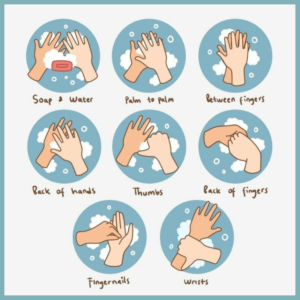Learn about the 5 Moments of Hand Hygiene and their importance in preventing infections. Essential information for healthcare workers and the general public. Hand hygiene is a crucial aspect of healthcare that is often overlooked. It is a simple yet effective way to prevent the spread of infection and disease, and it is essential for all healthcare workers to understand the importance of proper hand hygiene.
In this article, we will discuss the five key moments of hand hygiene and provide guidance on how to perform hand hygiene correctly. We will also explore the role of hand sanitizers in hand hygiene and provide tips for using them effectively.
By following these guidelines, healthcare workers can reduce the risk of infection and provide a safer environment for patients and staff.
Table of Contents
The Importance of Hand Hygiene
As the saying goes, cleanliness is next to godliness. And when it comes to healthcare, nothing could be truer. Proper hand hygiene is one of the most crucial aspects of maintaining cleanliness in healthcare settings.
Not only does it prevent the spread of infections, but it also protects both healthcare providers and patients from harmful pathogens. In this article, we’ll explore the importance of hand hygiene and techniques you can use to keep your hands clean and germ-free.
Understanding Hand Hygiene
Hand hygiene refers to the process of cleansing your hands using soap and water or an alcohol-based hand sanitizer. It’s a simple yet effective way to prevent the spread of infections. When you touch a contaminated surface or someone who’s sick, you can pick up germs on your hands. Washing your hands or using hand sanitizer removes these germs, reducing the likelihood that you’ll infect others.
Why Hand Hygiene is Important
The importance of hand hygiene cannot be emphasized enough. Germs, bacteria, and viruses are present on every surface you touch. When you’re in a healthcare setting, you’re exposed to a higher concentration of pathogens.
Proper hand hygiene helps prevent the spread of these harmful pathogens, reducing the risk of healthcare-associated infections (HAIs). HAIs are infections that patients acquire during their stay at a healthcare facility, and they can be devastating. They can cause severe illness, prolonged hospital stays, and even death.
HAIs also increase healthcare costs and put a strain on healthcare resources. Proper hand hygiene is crucial in preventing these infections and keeping patients safe.
Before Patient Contact: Hand Hygiene
When to Perform Hand Hygiene
Hand hygiene should be performed before and after any patient contact. Before you come into contact with a patient, it’s important to make sure your hands are clean. This reduces the risk of transmitting any pathogens to the patient.
Proper Technique for Hand Sanitizing
When performing hand hygiene with a hand sanitizer, make sure to follow these steps:
1. Apply a palmful of hand sanitizer to your hands.
2. Rub the sanitizer all over your hands, including between your fingers and on the backs of your hands.
3. Continue rubbing until the sanitizer is dry. Make sure your hands are completely dry before you come into contact with the patient.
After Patient Contact: Hand Hygiene
When to Perform Hand Hygiene
After you come into contact with a patient, it’s essential to perform hand hygiene. This helps prevent the spread of any germs or pathogens the patient may be carrying.
Proper Technique for Hand Washing

When washing your hands, follow these steps:
1. Wet your hands with warm water.
2. Apply soap and lather your hands thoroughly.
3. Rub your hands together for at least 20 seconds, making sure to scrub between your fingers and under your nails.
4. Rinse your hands thoroughly with water.
5. Dry your hands with a clean towel. Make sure to turn off the faucet with a paper towel to avoid re-contaminating your hands.
Before Aseptic Task: Hand Hygiene
What are Aseptic Tasks
Aseptic tasks refer to any procedures that require a sterile environment. These tasks may include inserting a catheter, performing surgery, or inserting an IV. It’s crucial to perform hand hygiene before these tasks to prevent the transmission of pathogens into sterile areas.
Proper Technique for Hand Washing
When performing hand hygiene before an aseptic task, follow the steps for hand washing. It’s also essential to wear gloves and other protective equipment as needed to maintain a sterile environment. Proper hand hygiene is critical in preventing the transmission of infections and keeping patients safe. By following these tips, you can help protect yourself and your patients.
After Body Fluid Exposure: Hand Hygiene
When it comes to body fluid exposure, hand hygiene is a must. It is important to understand what is considered body fluids – blood, saliva, urine, vomit, and any other bodily fluids. In case of inadvertent or accidental exposure to such fluids, it is important to immediately begin the hand hygiene process.
To start with, remove any contaminated clothing or accessories and rinse the affected area under running water. Next, wash your hands with soap and water for at least 20 seconds, making sure to scrub in between your fingers, under your nails, and the back of your hands. Finally, rinse your hands with warm water and dry them completely with a clean towel.
After Removing Gloves: Hand Hygiene
Gloves are essential when it comes to protecting yourself from infection or contamination. However, it is also equally important to remember to perform hand hygiene after removing gloves.
It is recommended to wash your hands with soap and water for at least 20 seconds or use an alcohol-based hand sanitizer to kill any germs that may have transferred from the gloves to your hands. It is important to remember that hand hygiene should be performed immediately after removing gloves as well as before putting them on.
The Role of Hand Sanitizers in Hand Hygiene
Hand sanitizers are a convenient and effective alternative to hand washing when soap and water are not readily available. However, it is important to understand when to use hand sanitizers and how to use them properly. Hand sanitizers should be used when your hands are not visibly dirty or greasy.
To use a hand sanitizer, apply a dime-sized amount to the palm of your hand and rub your hands together, making sure to cover all surfaces of your hands and fingers, until the sanitizer has completely evaporated. Remember, while hand sanitizers are a great option in a pinch, they do not replace proper hand washing when your hands are visibly dirty or contaminated.
Proper Technique for Hand Washing and Sanitizing
Whether you’re washing your hands with soap and water or using a hand sanitizer, proper technique is key. When washing your hands, make sure to wet your hands with warm water and apply soap. Rub your hands together for at least 20 seconds, making sure to clean in between your fingers, under your nails, and on the back of your hands.
Rinse your hands with warm water and dry completely with a clean towel. When using a hand sanitizer, make sure to apply a dime-sized amount to the palm of your hand and rub your hands together, making sure to cover all surfaces of your hands and fingers until the sanitizer has completely evaporated. By following these simple hand hygiene practices, you can help protect yourself and others from spreading germs and infections.
In conclusion, hand hygiene is a vital component of healthcare that should not be taken lightly. By following the 5 moments of hand hygiene and using hand sanitizers correctly, healthcare workers can significantly reduce the spread of infection and disease in their workplace.
Remember, proper hand hygiene not only protects patients but also safeguards the health and well-being of healthcare workers. By making hand hygiene a priority, we can create a safer and healthier environment for everyone.
Frequently Asked Questions (FAQ)
Why is hand hygiene important in healthcare?
Hand hygiene is crucial in healthcare because it helps prevent the spread of infection and disease. Healthcare settings can be breeding grounds for germs and bacteria, so proper hand hygiene is crucial for protecting patients and healthcare workers from harm.
What are the 5 moments of hand hygiene?
The five moments of hand hygiene are before patient contact, after patient contact, before the aseptic task, after body fluid exposure, and after removing gloves. Following these five key moments can help reduce the spread of infection and disease in healthcare settings.
Can hand sanitizers replace hand washing?
While hand sanitizers are a useful tool in hand hygiene, they should not replace hand washing. Hand washing with soap and water is still the most effective way to remove dirt, grime, and harmful bacteria from your hands. Hand sanitizers should be used as a complement to hand washing, not a replacement.
What are the consequences of poor hand hygiene?
Poor hand hygiene can have serious consequences, including the spread of infection and disease. In healthcare settings, poor hand hygiene can lead to hospital-acquired infections, which can be life-threatening for patients. Additionally, poor hand hygiene can lead to the spread of infectious diseases like the flu, colds, and COVID-19 in both healthcare and community settings.
- NVS Staff Nurse Vacancy 2024 – How to Apply
- AIIMS NORCET 6 and ESIC Nursing Exam Questions and Answers
- ESIC Nursing Officer Recruitment 2024 | 1930 Vacancies – Apply Now
- Dream Job Alert: AIIMS NORCET Nursing Officer Vacancy 2024 – Apply Now!
- NIMHANS Nursing Officer Exam 17-12-2023 Memory-Based Solved Questions




